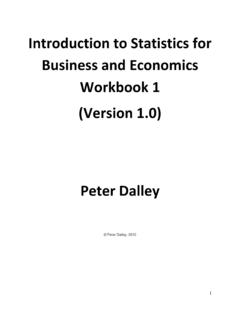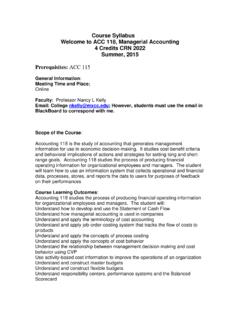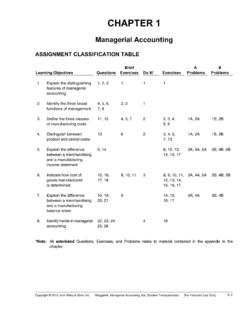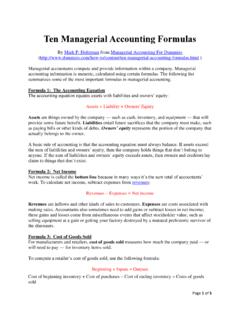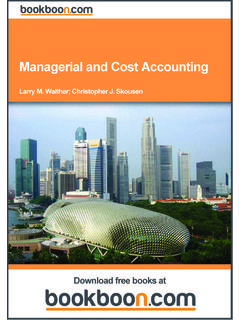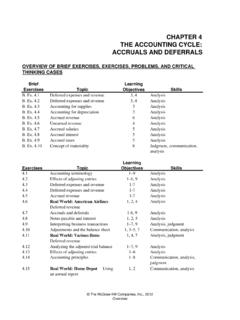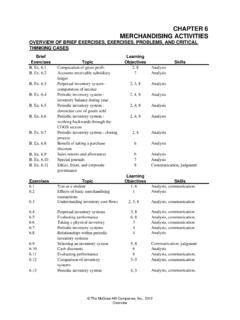Transcription of Managerial Accounting Workbook (Version 1.0) …
1 Managerial Accounting Workbook ( version ) Tony Bell Tony Bell, 2016 Table of Contents A Note to Instructors .. 3 Module 1: Introduction to Managerial Accounting .. 4 Module 2: Cost Concepts and the Schedule of Cost of Goods Manufactured .. 7 Module 3: Job-Order Costing .. 13 Module 4: Process Costing .. 22 Module 5: Activity-Based Costing .. 31 Module 6: Cost Behaviour .. 36 Module 7: Cost-Volume-Profit Analysis .. 42 Module 8: Budgeting .. 50 Module 9: Standard Costs and Variance Analysis .. 62 Module 10: Flexible Budgeting .. 69 Module 11: Performance Measurement: ROI, Residual Income and the Balanced Scorecard 72 Module 12: Relevant Costs for Decision Making .. 76 Module 13: Capital Budgeting .. 86 A Note to Instructors I hope you find this Workbook useful, I just want to point out three key features: 1.
2 This book is totally free to you and your students. Feel free to copy it or post it to your course website and feel free to share it with colleagues. 2.) Although I am widely distributing a PDF file, I have gone to great effort to make a fully editable Word version of this document. Please contact me if you d like to have a copy of the Word version . You can edit any of these problems to better fit in your class or simply copy and paste an entire problem into an assignment or test, with the attribution Source: , or Adapted from: . 3.) Every problem in this Workbook has a video walkthrough available at I suspect the true value in this book lies in the video walkthroughs, as it will be useful for homework and particularly useful for flipping the classroom . Please let me know if you would like to see additional question-types or topics included in the future.
3 I intend to add to this book frequently based on your input. Also, any feedback you can provide (particularly student feedback) would be greatly appreciated. Please note, you do not have my permission to use this for a commercial purpose, nor do you have permission to recreate the videos found at Send me an email if you have any questions about use or attribution. Thanks for checking out this Workbook , and I hope you ll have a look at the companion website: ! Tony Bell Module 1: Introduction to Managerial Accounting Author s note regarding Module 1 content: This Workbook was created to mirror most introductory management Accounting textbooks; as such, this is an unusual module. The first chapter in most textbooks is composed of purely qualitative content and this Workbook was built to match.
4 Subsequent modules in this Workbook will have A and B versions of numerical questions to allow students the opportunity to practice. 1-1 financial vs Managerial Accounting Distinguish between financial and Managerial Accounting . 1-2 - Ethics Explain the importance of ethics in Accounting . 1-3 Planning, Directing and Controlling The three main tasks of a manager are said to be planning, directing and controlling. Explain the three tasks. 1-4 Terminology and acronyms Define: JIT, TQM, ABC, theory of constraints, Six Sigma, and the balanced scorecard. Module 2: Cost Concepts and the Schedule of Cost of Goods Manufactured 2-1A Cost Classification The following are costs of Big Rig Trucks, a manufacturer of large diesel vehicles. 1.) Aluminum used in manufacturing each truck s body.
5 2.) Factory supervisor s salary. 3.) Company president s salary. 4.) Cleaning supplies used for daily cleanup. 5.) Wages of workers who build the engines. 6.) Patent lawyer s costs. 7.) Accounting fees. 8.) Depreciation on sales person s car. Required: For each cost, identify it as: a.) Variable or Fixed b.) Product or Period c.) Direct Material, Direct Labour, Manufacturing Overhead, Selling, Administrative or Research and Development. 2-1B Cost Classification The following are costs of Betty s Burger Truck a food truck operating in downtown Seattle. 1.) Cooks wages. 2.) Propane costs to heat the grill. 3.) Gasoline costs to travel to events. 4.) Painting company logo on the side of the truck. 5.) Business license. 6.) Depreciation on the cooking equipment. 7.) Costs of improving the recipe for new bison burger.
6 8.) Burger meat. Required: For each cost, identify it as: a.) Variable or Fixed b.) Product or Period c.) Direct Material, Direct Labour, Manufacturing Overhead, Selling, Administrative or Research and Development. 2-2A Schedule of Cost of Goods Manufactured Kelowna Plumbing Supplies shows the following data related to its December 31, 2017 fiscal year: Raw materials inventory, January 1, 2017 $5,000 Raw materials inventory, December 31, 2017 8,000 Work in process inventory, January 1, 2017 23,000 Work in process inventory, December 31, 2017 21,000 Finished goods inventory, January 1, 2017 16,000 Finished goods inventory, December 31, 2017 10,000 Advertising 56,000 Factory supervisor's salary 42,000 Company president's salary 85,000 Property taxes - factory 25,000 Depreciation - factory 35,000 Factory maintenance 7,000 Sales commissions 32,000 Depreciation - office 2,000 Utilities expense - factory 23,000 Utilities expense - office 11000 Purchases of raw materials 148,000 Direct labour 160,000 Required: Based on the information above, prepare a schedule of cost of goods manufactured.
7 2-2B Schedule of Cost of Goods Manufactured Vernon Bakery shows the following data related to its August 31, 2017 fiscal year: Raw materials inventory, September 1, 2016 $2,400 Raw materials inventory, August 31, 2017 1,600 Work in process inventory, September 1, 2016 200 Work in process inventory, August 31, 2017 150 Finished goods inventory, September 1, 2016 1,000 Finished goods inventory, August 31, 2017 900 Rent on the commercial kitchen 12,000 Depreciation of delivery vehicle 1,500 Salary paid to head baker 42,000 Purchases of raw materials 58,000 Delivery costs 2,500 Utilities expense - office 600 Depreciation - kitchen equipment 2,000 Dividends paid to shareholders 10,000 Utilities expense - kitchen 1,200 Marketing 3,000 Wages paid to kitchen cleaning staff 16,000 Wages paid to assistant bakers 65,000 Required: Based on the information above, prepare a schedule of cost of goods manufactured.
8 2-3A Schedule of COGM, Schedule of COGS and Income Statement Outdoor Supplies manufactures gear for hunting and camping. The company shows the following data related to its December 31, 2017 fiscal year end: Raw materials inventory, January 1, 2017 $14,000 Raw materials inventory, December 31, 2017 17,000 Work in process inventory, January 1, 2017 31,000 Work in process inventory, December 31, 2017 20,000 Finished goods inventory, January 1, 2017 84,000 Finished goods inventory, December 31, 2017 68,000 Direct labour 275,000 Factory supervisor's wages 64,000 Company president's salary 120,000 Purchases of raw materials 425,000 Depreciation (60% factory, 40% office) 240,000 Property taxes (80% factory, 20% office) 20,000 Sales commissions 100,000 Repairs and maintenance (100% relate to the factory) 15,000 Utilities expense (90% factory, 10% office) 30,000 Sales revenue 2,050,000 Advertising 215,000 Required.
9 Based on the information above: a.) Prepare a schedule of cost of goods manufactured. b.) Prepare a schedule of cost of goods sold. c.) Prepare an income statement (assuming a tax rate of 20%.) 2-3B Schedule of COGM, Schedule of COGS and Income Statement HiSing manufactures beverages for the Taiwanese market. The following data relate to its July 31, 2017 fiscal year end: Raw materials inventory, August 1, 2016 $185,000 Raw materials inventory, July 31, 2017 140,000 Work in process inventory, August 1, 2016 25,000 Work in process inventory, July 31, 2017 35,000 Finished goods inventory, August 1, 2016 375,000 Finished goods inventory, July 31, 2017 390,000 Direct labour 1,200,000 Sales commissions 400,000 Factory supervisors wages 240,000 Company president's salary 250,000 Purchases of raw materials 3,250,000 Property taxes (75% factory, 25% office) 100,000 Depreciation (90% factory, 10% office) 1,700,000 Repairs and maintenance (95% factory, 5% office) 200,000 Utilities expense (90% factory, 10% office) 600,000 Sales revenue 10,300,000 Advertising 2,000,000 Required: Based on the information above.
10 D.) Prepare a schedule of cost of goods manufactured. e.) Prepare a schedule of cost of goods sold. f.) Prepare an income statement (assuming a tax rate of 25%.) Module 3: Job-Order Costing 3-1A Job Order Costing vs Process Costing For each of the companies listed below, note which costing method would be more appropriate: Job Order Costing (J), or Process Costing (P): a.) A company that does car repair b.) A company that does architectural design c.) A company that makes yoga mats d.) A company that gives immigration consulting advice e.) A company that refines oil into gasoline f.) An Accounting firm g.) A company that manufactures crayons h.) A company that makes designer handbags 3-1B Job Order Costing vs Process Costing For each of the companies listed below, note which costing method would be more appropriate: Job Order Costing (J), or Process Costing (P): a.

